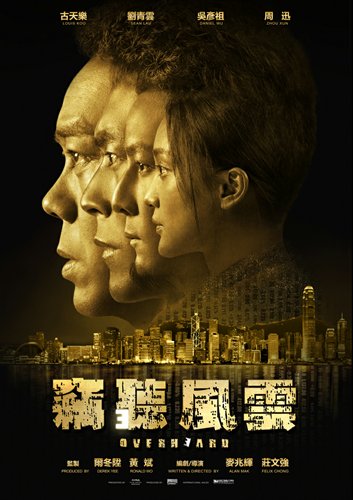

Poster for Overheard 3 Photos: Courtesy of Xinyilian
Plagiarism and a lack of originality are the two most common elements Chinese moviegoers notice when it comes to locally produced movie posters. From small and mid-budget films to giant blockbusters, the habit of local posters to "imitate" global classics could be easily seen a few years ago by anyone who cared to look.
China's "almighty" netizens once posted several examples of this phenomenon on the Internet: A poster for Chinese disaster feature Jingtian Dongdi (2009) was accused of copying the poster for Hollywood war flick Flags of Our Fathers (2006) as both depict a group of soldiers holding a flag against a dark clouded sky; Chinese romantic comedy Dear Enemy (2011) and American documentary Fahrenheit 9/11 (2004) both feature a giant document folder stamped "confidential"; a poster for China's The Allure of Tears (2011) seems to be the long lost twin of the South Korean film Sad Movie (2005).
Luckily, the situation seems to have been changing for the better in recent years. As domestic movie producers begin to realize that a poster is more than a simple picture, original ideas are becoming an essential part of poster design.
Finding their own path
Considering cinema's short history, it's somewhat understandable that poster design has gone ignored in China for decades.
"There simply was no such industry [as poster designing] in the early days. They used to hire teachers at art academies to draw posters for movies," Wang Daning, general manager of film advertising company Xinyilian Culture Communication, told the Global Times.
According to Wang, compared to Hong Kong and Taiwan, where the movie poster sector was already "rather mature" in the 1980s-90s, the mainland did not see a developing film market until the early 2000s.
"It's only when a film market develops that there will be job opportunities for poster designers," Wang explained.
Believing posters should not to stick to a single pattern, Wang and his team encountered a lot of restrictions when they first started designing posters. One of these being that production companies at the time preferred posters featuring the "gathered heads" of that particular film's stars, since they wanted to get their money's worth out of the stars they had paid for.
It was only until around three years ago that the demand for original posters really began to take off, although some in the media take the poster for director Jiang Wen's 2007 feature Sun Also Rises as the starting point of original "concept posters," as it doesn't focus on showing the stars of the film or some a grand scene, but rather looks to convey the tone of the film.
Zhang Haifeng, a mainland poster designer, regards poster copycats as "products of a transitional period."
"When the [domestic] movie industry first got its start, few people understood how to handle promotion. So production companies had no choice but to learn from Hollywood posters," Zhang told the Global Times, adding that an obvious change has taken place in recent years. "Most movie directors or investors will now involve themselves in the designing of posters. Now starting to pay attention to originality, many demand that their posters be different from earlier works."
Zhang sees the whole transformation of the industry as going from flying blind to being more target-orientated.
Expanding poster industry
Along with the rising attention towards original posters, people working in the industry are also receiving better treatment and more respect from movie producers.
While poster design used to be a single department belonging to a design or advertising company, more and more independent companies and studios have begun to spring up in China.
Wang's Xinyilian started as a small studio in 2007 but is now a company of nearly 20 employees. Business has increased as well, "In 2008, we received cases from less than 20 movies. Last year, that number went beyond 40," Wang said.
And Zhang, who currently works for EDKO Film, is preparing to establish his own movie poster studio.
Zhang said the future will have a greater and more varied demand for poster design. "[Posters will have to be] more professional and more unique. So there will not only be big companies but also small studios as well," Zhang said, adding that there are many small size poster studios overseas.
The rising importance attached to poster design can also be seen from the amount of support film producers are giving to designers to finish their work.
Wang and his team used to design posters based on stage photos, and even if they were allowed to be on set, they usually had to wait an entire day just to get a half an hour shoot. Now his team is treated as part of the film crew and is part of production right from the start.
Hong Kong director Tsui Hark's latest work Tracks in The Snowy Forest, for example, provided Wang three opportunities to take photos specifically for poster production getting a half an hour with each of the 20 members of the film.
However, he pointed out that income for designers is still low compared to advertising or game poster designers, which is worrying because it may cause a flow of talent out of the industry.
On the whole, the budding industry in the Chinese mainland is attracting an increasing amount of opportunities from Hong Kong and abroad. Meanwhile, designers are constantly looking for ways to improve the quality of their work within the industry.
"You need to build an interaction with the audience," Wang explained, pointing out that posters for a comedy should make people laugh the first time they see it, while a poster for a romance should make people think of love.
Award-winning posters exhibited in Hangzhou
2013-11-29Final posters of "Nightfall" unveiled
2012-02-20Copyright ©1999-2018
Chinanews.com. All rights reserved.
Reproduction in whole or in part without permission is prohibited.